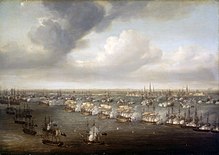George Murray (Royal Navy officer, born 1759)
Sir George Murray | |
|---|---|
American War of Independence
| |
| Awards | Knight Commander of the Order of the Bath Naval Gold Medal |
Family and early life
George Murray was born in
Home waters
Howe and Murray returned to England in 1778. Howe was disaffected by his experiences of command in North America, and consequently did not bestow patronage on those junior officers under his command, as was the custom. Instead a friend of Murray's father, Captain
East Indies
Murray had made it back to England by early 1781 and received an appointment to the 64-gun
Murray received his first command on 9 October 1782, that of the
Years of peace
Without active employment following the Peace of Paris and the end of the American War of Independence, Murray spent several years in study, residing in France for a two-year period in order to refine his language skills.[3][5] The Nootka Crisis in June 1790 led to Murray's return to service in command of the 32-gun frigate HMS Triton. He continued in her for the next few years, and by April 1791 he was occupied in surveying the Great Belt, and the approaches into Copenhagen. He spent the remainder of the peace serving at Halifax and Jamaica, returning to England in June 1793 after the outbreak of the French Revolutionary Wars.[5]
French Revolutionary Wars
He was appointed to the 36-gun
Jervis and Cape St Vincent

Murray's next assignment was to take command of the 74-gun
Loss of the Colossus
Murray continued to serve with Jervis until he was despatched to join
Nelson and Copenhagen

Detached with Nelson's expeditionary squadron for the expeditionary assault on Copenhagen on 2 April, Murray was given the task of leading the British force into the harbour, using channels he had helped to chart a decade earlier.[1] She eventually passed by four Danish ships, taking fire from each one, before anchoring opposite the Jylland, which she engaged for the next four hours of the battle.[1][8] By the time the truce was concluded, the Edgar had taken casualties of 31 killed and 104 wounded. During the peace negotiations with the Danish, and the subsequent foray to watch the Swedish forces at Karlskrona, Murray developed a strong rapport with Nelson, who had replaced Parker after the latter's recall to Britain.[1]
Captain of the fleet
With the resumption of hostilities after the
the nature of the service was such, as very frequently terminated in disagreement between the admiral and the captain; and he should be extremely unwilling to hazard any possible thing that should diminish the regard and respect which he should ever entertain for his lordship.[1]
Nelson's response was to express agreement with Murray that such situations could occur, but reminded him that
on whatever he [Murray] might be called, or whatever measure he might be directed to carry into execution, he never should forget the intimacy which subsisted between them; and even, should anything go contrary to his wishes, he would wave the rank of admiral, and explain, or expostulate with him, as his friend, Murray.[1]
Murray then accepted the post, and remained with Nelson as his captain of the fleet during the blockade of Toulon between 1803 and 1805, and the subsequent chase of Villeneuve and his fleet to the West Indies and back in 1805.[3] He had been promoted to rear-admiral on 23 April 1804, but declined to raise his flag so as to be able to continue on with Nelson. The fleet returned to England in August 1805, where Murray learnt that his father-in-law had died, leaving him as executor of his estates. While Nelson sailed to take up command of the fleet blockading Cadiz, Murray was compelled to remain in England and attend to family affairs.[1] Nelson did not therefore have a captain of the fleet at Trafalgar, for as one biographer stated "none but Murray would do".[1]
Later service

Murray's last operational command was in November 1806, when he was assigned as commander-in-chief of the naval forces involved in the
He died suddenly at his home in Chichester on 28 February 1819. His obituary reported that he had gone to bed "in good health, and was seized by a spasmodic affectation in his chest, which terminated his existence at 8 o'clock".
Notes
- ^ a b c d e f g h i j k l m n Tracy. Who's who in Nelson's Navy. p. 258.
- ^ a b c d Tracy. Who's who in Nelson's Navy. p. 256.
- ^ doi:10.1093/ref:odnb/19607. Retrieved 28 November 2010. (Subscription or UK public library membershiprequired.) (subscription required)
- ^ a b "Murray, Sir George (1759–1819)". Dictionary of National Biography. 1894. p. 362.
- ^ a b c d e f g h i j k l m Tracy. Who's who in Nelson's Navy. p. 257.
- ^ Colledge. Ships of the Royal Navy. p. 19.
- ^ Adkin. The Trafalgar Companion. p. 160.
- ^ Adkin. The Trafalgar Companion. p. 466.
- ^ "Past Mayors". Chichester City Council. Retrieved 8 May 2016.
- The European Magazine, and London Review. p. 273.
- ^ Tracy. Who's who in Nelson's Navy. p. 259.
References
- Adkin, Mark (2007). The Trafalgar Companion: A Guide to History's Most Famous Sea Battle and the Life of Admiral Lord Nelson. London: Aurum Press. ISBN 978-1-84513-018-3.
- ISBN 978-1-86176-281-8.
- Tracy, Nicholas (2006). Who's who in Nelson's Navy: 200 Naval Heroes. London: Chatham Publishing. ISBN 978-1-86176-244-3.
- Laughton, J. K. (1894). Leslie Stephen (ed.). Oxford Dictionary of National Biography. Vol. 39. Oxford University Press.
- The European Magazine, and London Review. Vol. 75. Philological Society of London. 1819.
